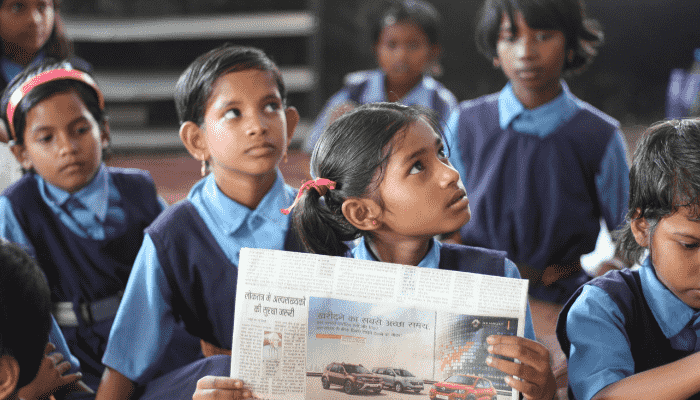Nelson Mandela once said, “Like slavery and apartheid, poverty is not natural. It is man-made, and it can be overcome and eradicated by the actions of human beings.” One of the most effective and sustainable ways to eliminate poverty is through proper school education and skill development. While India’s skills gap and job creation crisis are widely discussed, significant developments are underway with respect to job formalization and the establishment of a dedicated Ministry of Skills. However, we must also be cognizant of the importance of school education in laying the foundation for skill development. In the absence of this awareness, we may well find ourselves in a situation where we suffer from a shortage of trainable workers. What India grapples with today as a skills crisis may soon evolve into a schooling crisis, requiring systemic reforms that align all stakeholders toward the goal of improving learning outcomes.
Why school education is critical for India’s future
The importance of school education in India cannot be overstated. Firstly, basic literacy and numeracy skills—such as the ability to read, fill out job applications, calculate change, or follow medical advice—empower individuals to navigate everyday life. In the evolving world of work, where automation and artificial intelligence (AI) are increasingly prevalent, basic skills like reading, writing, and arithmetic (the 3Rs) are more crucial than ever. Furthermore, soft skills such as creativity, problem-solving, interpersonal communication, and critical thinking are now as important as hard skills.
Secondly, preparing individuals during their formative years is far more effective than attempting to repair educational gaps later in life through short-term skills training programs. It’s clear that what students fail to learn over 12 years of schooling cannot be adequately addressed in six-month vocational courses.
India’s economic transition from agriculture to non-farm jobs differs from China’s factory-based transition. India’s shift is primarily toward service roles such as sales, customer service, and logistics. In these sectors, even small improvements in literacy and numeracy can significantly boost wages. For example, a driver who can navigate using Google Maps, a security guard who answers phones, or a plumber who uses WhatsApp shows the importance of digital literacy and foundational education in today’s workforce.
In addition, job migration patterns reveal that while it’s not always possible to bring jobs to people, it is possible—and necessary—to provide a quality school education before they migrate to urban centres or take on service-oriented roles. A solid educational foundation greatly improves the long-term employment outcomes of migrant workers.
Current challenges in India’s school education system
India’s school system faces well-known challenges where many Class 8 students struggle with tasks that should have been mastered in earlier grades, revealing significant gaps in learning. The current education system places excessive emphasis on inputs—such as teacher qualifications, salaries, and class sizes—while often neglecting the quality of learning outcomes. This approach focuses too much on infrastructure, confusing well-built schools with well-functioning educational institutions.
Furthermore, the school curriculum is heavily geared toward memorization, with students encouraged to focus on knowledge retention rather than critical thinking and problem-solving. In an era where information is readily available online, education should emphasize the development of critical thinking skills and creativity. As poet William Butler Yeats wisely remarked, “Education is not the filling of a bucket but the lighting of a fire.”
Another key issue lies in teacher performance management. In government schools, politically influenced transfer policies, automatic career progression guarantees, and other structural inefficiencies diminish accountability. This makes it difficult to ensure that teachers are both motivated and held responsible for student outcomes.
A roadmap for education reform
A recent World Bank report on education offers valuable insights into why schooling often fails to translate into learning and proposes actionable strategies to address this. It identifies four key reasons for the failure of school systems like India’s:
- Unskilled and Demotivated Teachers: Many teachers lack the necessary training and motivation to effectively educate students.
- Unprepared Learners: A large portion of students come from backgrounds that do not provide adequate support for learning.
- Ineffective School Inputs: Despite investment in infrastructure, school inputs often fail to improve actual learning.
- Inadequate Governance: Poor management and governance structures contribute to systemic inefficiencies.
To address these challenges, the report suggests three core strategies:
- Assess Learning Regularly: Continuously evaluate students’ learning levels and use the results to guide targeted educational interventions.
- Implement Evidence-Based Practices: Use data and evidence to guide education innovation and ensure that proven teaching methods are scaled effectively.
- Align Stakeholders for Systemic Change: All stakeholders—politicians, teachers, parents, and students—must work together to improve learning outcomes.
In India, the third recommendation is especially crucial, as various education stakeholders often have competing interests. Politicians may focus on serving specific voter bases, while bureaucrats and teachers prioritize job security. Unfortunately, the groups that stand to benefit most from education reforms—students, parents, and employers—often lack the power, information, or incentive to drive systemic change. This creates a vicious cycle of low accountability, poor learning outcomes, and growing inequality.
The way forward for India’s school system
India’s path to reforming its education system is clear. The Right to Education Act should be transformed into a “Right to Learning Act,” shifting the focus from school enrollment to actual learning outcomes. Additionally, decentralizing school regulation—giving states more control over their education systems—could lead to more effective and locally relevant solutions. This is similar to the U.S.’s transition from the No Child Left Behind Act to the Every Student Succeeds Act.
India’s board exams should also be revised to better balance the development of soft skills like communication and critical thinking with traditional academic skills. Government schools, which play a critical role in educating a large portion of the population, should be equipped with stronger governance systems to ensure teacher accountability and improved student performance.
Mahatma Gandhi once said, “Live as if you were to die tomorrow, but learn as if you were to live forever.” Yet, many of India’s schools are not preparing students for even the next decade, let alone forever. This isn’t an unsolvable issue like climate change or cancer—it’s a matter of addressing structural inefficiencies. Now that it’s clear that fixing the skills gap is impossible without addressing fundamental problems in K-12 education, India must build an education system centred on learning and preparing students not just for the future of work, but for life itself.
You might be also interested to read: Apprenticeships As Classrooms: Reforming India’s Skilling System






